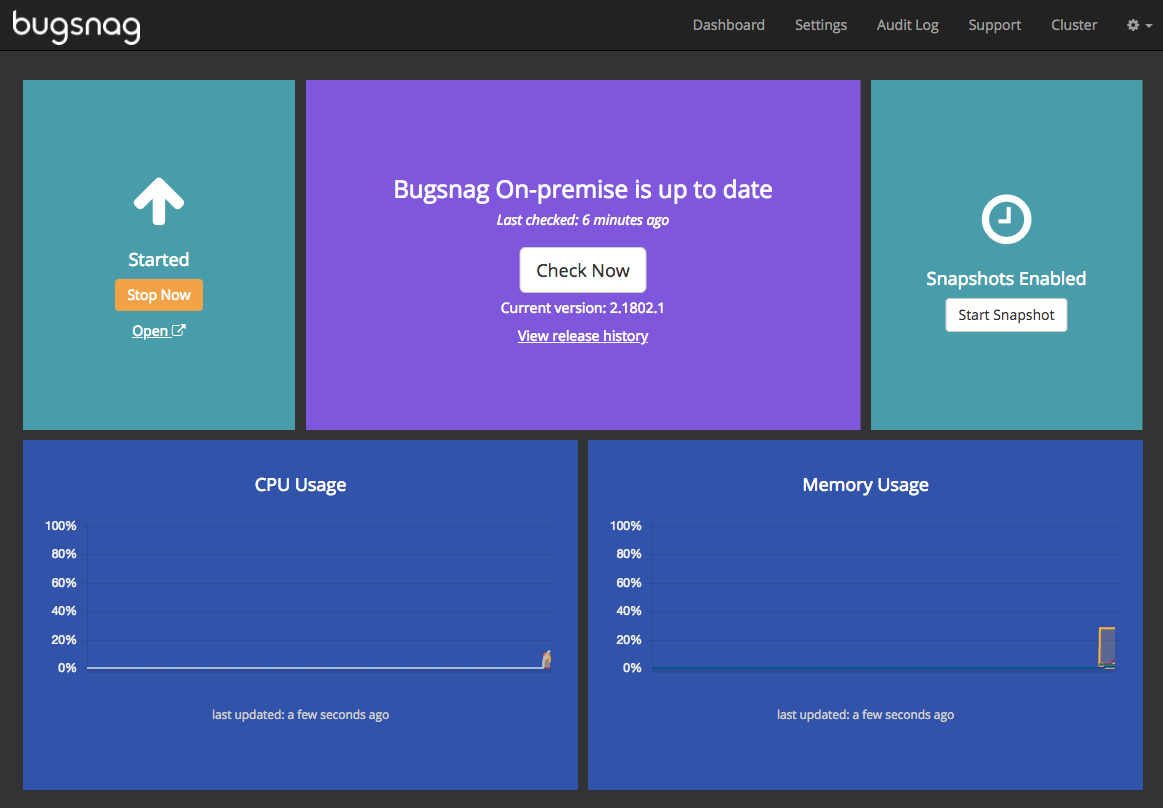 BugSnag is now Insight Hub – we're making some changes to how the product looks, but this won't impact the way you use BugSnag or any of your integrations.
BugSnag is now Insight Hub – we're making some changes to how the product looks, but this won't impact the way you use BugSnag or any of your integrations.
Installation guide
Install your On-premise version of BugSnag on an internet connected machine.
This page refers to BugSnag On-premise legacy single machine version 3. For the latest information please see BugSnag On-premise.
Before installation
To get started with your BugSnag On-premise installation, you’ll need the following things prepared in advance:
- If this is your first time installing BugSnag On-premise, you’ll need to contact us to schedule a guided installation. We’ll get you set up with a license key, and walk you through the installation process.
- A server meeting the minimum system requirements.
- SMTP credentials are required for installation. These are used to invite collaborators and receive error notification emails.
Installation
If you are installing BugSnag On-premise on a machine without an internet connection please follow the airgapped installation guide.
BugSnag On-premise uses Replicated to perform and manage installations. To install BugSnag On-premise we first need to install and configure Replicated.
Install Replicated
Run the install script to download and install the Replicated management console.
curl -sSL -o replicated_install.sh https://get.replicated.com/docker/bugsnag/stable
sudo bash replicated_install.sh \
no-auto
The Replicated install script may ask some questions during the installation process. Instructions for these are below,
IP address of the machine
The installation script will attempt to automatically detect the private IP address of the machine. If the script is unable to detect the machine’s IP address it will present you a list of network interfaces to choose from, select the one has the machine’s IP address on your network. Typically this will be the eth0 network.
Proxy settings
If you are installing behind a proxy you can enter the proxy details here.
Install Docker
If you do not already have Docker installed on your machine the script will install the recommended version (20.10.7). Some environments may require additional configuration to install Docker with a production-ready and stable configuration.
From Docker 18.09, the Docker CLI and containerd.io are in separate packages and should be installed or updated at the same time as the Docker Engine. To ensure you are running a compatible version of containerd.io for your version of Docker, see the Docker release notes
Access the Replicated management console
After installation, the Replicated management console will be available at https://SERVER_IP:8800.
Upon first visiting the Replicated management console you will be asked to set a hostname and certificate for the management console. Doing so will remove the SSL certificate warning when accessing the management console, but you can continue with the self-signed certificate and update this later if you prefer.
Install BugSnag On-premise
Upload license
In the Replicated management console you will be asked to upload your BugSnag On-premise license key. Upload the license key you received from BugSnag to continue to the next step.
Management console password
Once the license has been uploaded and validated, you should set a password for the management console - this is particularly important if you are exposing it to a public network and will be required to access the management console again in the future.
Preflight checks
You will then be presented with the preflight check page, this will analyze the system to determine if the environment meets the minimum requirements. These checks are done to ensure that your installation is successful, and although you can skip these checks and force an installation, we recommend you consult with us before doing so.
BugSnag configuration
Finally, configure your installation as directed on the settings page, save and start BugSnag.
It can take several minutes for BugSnag On-premise to fully start up; when it is ready the management console will indicate that it is Started.

Account & project creation
Now BugSnag is running, you should be able to access the BugSnag dashboard, where you’ll need to create your account and first project.
Visit your BugSnag dashboard in a web browser (available by default at x.x.x.x:49080) to set up your account and create projects for each of the applications you wish to monitor.
Configure platform SDKs
Once you have created your account and first project, follow the instructions to configure platform SDKs so your applications send error and session information to your BugSnag instance.